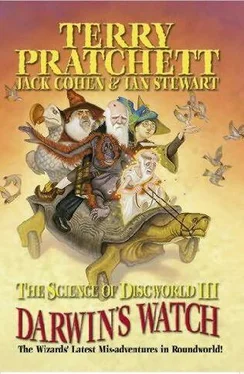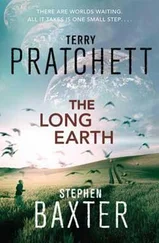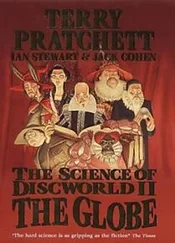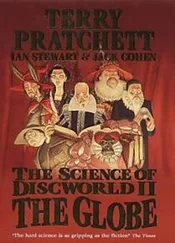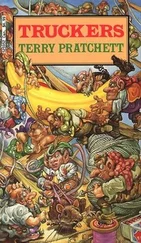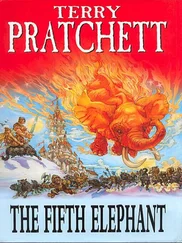Terry Pratchett - The Science of Discworld III - Darwin's Watch
Здесь есть возможность читать онлайн «Terry Pratchett - The Science of Discworld III - Darwin's Watch» весь текст электронной книги совершенно бесплатно (целиком полную версию без сокращений). В некоторых случаях можно слушать аудио, скачать через торрент в формате fb2 и присутствует краткое содержание. Жанр: Фантастика и фэнтези, на английском языке. Описание произведения, (предисловие) а так же отзывы посетителей доступны на портале библиотеки ЛибКат.
- Название:The Science of Discworld III - Darwin's Watch
- Автор:
- Жанр:
- Год:неизвестен
- ISBN:нет данных
- Рейтинг книги:3 / 5. Голосов: 1
-
Избранное:Добавить в избранное
- Отзывы:
-
Ваша оценка:
- 60
- 1
- 2
- 3
- 4
- 5
The Science of Discworld III - Darwin's Watch: краткое содержание, описание и аннотация
Предлагаем к чтению аннотацию, описание, краткое содержание или предисловие (зависит от того, что написал сам автор книги «The Science of Discworld III - Darwin's Watch»). Если вы не нашли необходимую информацию о книге — напишите в комментариях, мы постараемся отыскать её.
The Science of Discworld III - Darwin's Watch — читать онлайн бесплатно полную книгу (весь текст) целиком
Ниже представлен текст книги, разбитый по страницам. Система сохранения места последней прочитанной страницы, позволяет с удобством читать онлайн бесплатно книгу «The Science of Discworld III - Darwin's Watch», без необходимости каждый раз заново искать на чём Вы остановились. Поставьте закладку, и сможете в любой момент перейти на страницу, на которой закончили чтение.
Интервал:
Закладка:
Since Tegmark's principle doesn't work for coins, it makes no sense to suppose that it works for universes.
The evidence advanced in favour of level 4 parallel worlds is even thinner. It amounts to a mystical appeal to Eugene Wigner's famous remark about `the unusual effectiveness of mathematics' as a description of physical reality. In effect, Tegmark tells us that if we can imagine something, then it has to exist.
We can imagine a purple hippopotamus riding a bicycle along the edge of the Milky Way while singing Monteverdi. It would be lovely if that meant it had to exist, but at some point a reality check is in order. We don't want to leave you with the impression that we enjoy pouring cold water over every imaginative attempt to convey a feeling for some of the remarkable concepts of modern cosmology and physics. So we'll end with a very recent addition to the stable of parallel worlds, which has quite a few things going for it. Perhaps unsurprisingly, the main thing not currently going for it is a shred of experimental evidence.
The new theory on the block is string theory. It provides a philosophically sensible answer to the age-old question: why are we here? And it does so by invoking gigantic numbers of parallel universes.
It is just much more careful how it handles them.
Our source is an article, `The String Theory Landscape' by Raphael Bousso and Joseph Polchinski, in the September 2004 issue of Scientific American - a special issue on the theme of Albert Einstein.
If there is a single problem that occupies the core of modern physics, it is that of unifying quantum mechanics with relativity. This search for a `theory of everything' is needed because although both of those theories are extraordinarily successful in helping us to understand and predict various aspects of the natural world, they are not totally consistent with each other. Finding a consistent, unified theory is hard, and we don't yet have one. But there's one mathematically attractive attempt, string theory, which is conceptually appealing even though there's no observational evidence for it.
String theory holds that what we usually consider to be individual points of spacetime, dimensionless dots with no interesting structure of their own, are actually very, very tiny multidimensional surfaces with complicated shapes. The standard analogy is a garden hose. Seen from some way off, a hose looks like a line, which is a onedimensional space - the dimension being distance along the hose. Look more closely, though, and you see that the hose has two extra dimensions, at right angles to that line, and that its shape in those directions is a circular band.
Maybe our own universe is a bit like that hosepipe. Unless we look very closely, all we see is three dimensions of space plus one of time - relativity. An awful lot of physics is observed in those dimensions alone, so phenomena of that type have a nice four-dimensional description - relativity again. But other things might happen along extra `hidden' dimensions, like the thickness of the hose. For instance, suppose that at each point of the apparent four-dimensional spacetime, what seems to be a point is actually a tiny circle, sticking out at right angles to spacetime itself. That circle could vibrate. If so, then it would resemble the quantum description of a particle. Particles have various `quantum numbers' such as spin. These numbers occur as whole number multiples of some basic amount. So do vibrations of a circle: either one wave fits into the circle, or two, or three ... but not two and a quarter, say.
This is why it's called `string theory'. Each point of spacetime is replaced by a tiny loop of string.
In order to reconstruct something that agrees with quantum theory, however, we can't actually use a circular string. There are too many distinct quantum numbers, and plenty of other problems that have to be overcome. The suggestion is that instead of a circle, we have to use a more complicated, higher-dimensional shape, known as a `bran' [43] Derived from a pun: m-bran for `membrane'. Opening up jokes about no-branes and p-branes. Oh well.
. Think of this as a surface, only more so. There are many distinct topological types of surface: a sphere, a doughnut, two doughnuts joined together, three doughnuts ... and in more dimensions than two, there are more exotic possibilities.
Particles correspond to tiny closed strings that loop around the brane. There are lots of different ways to loop a string round a doughnut - once through the hole, twice, three times ... The physical laws depend on the shape of the brane and the paths followed by these loops.
The current favourite brane has six dimensions, making ten in all. The extra dimensions are thought to be curled up very tightly, smaller than the Planck length, which is the size at which the universe becomes grainy. It is virtually impossible to observe anything that small, because the graininess blurs everything and the fine detail cannot be seen. So there's no hope of observing any extra dimensions directly. However, there are several ways to infer their presence indirectly. In fact, the recently discovered acceleration in the rate of expansion of the universe can be explained in that manner. Of course, this explanation may not be correct: we need more evidence.
The ideas here change almost by the day, so we don't have to commit ourselves to the currently favoured six-dimensional set-up. We can contemplate any number of different branes and differently arranged loops. Each choice - call it a loopy brane - has a particular energy, related to the shape of the brane, how tightly it is curled up, and how tightly the loops wind round it. This energy is the 'vacuum energy' of the associated physical theory. In quantum mechanics, a vacuum is a seething mass of particles and antiparticles coming into existence for a brief instant before they collide and annihilate each other again. The vacuum energy measures how violently they seethe. We can use the vacuum energy to infer which loopy brane corresponds to our own universe, whose vacuum energy is extraordinarily small. Until recently it was thought to be zero, but it's now thought to be about 1/120plex units, where a unit is one Planck mass per cubic Planck length, which is a googol grammes per cubic metre.
We now encounter a cosmic `three bears' story. Macho Daddy Bear prefers a vacuum energy larger than +1/118plex units, but such a spacetime would be subject to local expansions far more energetic than a supernova. Wimpy Mummy Bear prefers a vacuum energy smaller than -1/120plex units (note the minus sign), but then spacetime contracts in a cosmic crunch and disappears. Baby Bear and Goldilocks like their vacuum energy to be `just right': somewhere in the incredibly tiny range between +1/118plex and -1/120plex units. That is the Goldilocks zone in which life as we know it might possibly exist.
It is no coincidence that we inhabit a universe whose vacuum energy lies in the Goldilocks zone, because we are life as we know it. If we lived in any other kind of universe, we would be life as we don't know it. Not impossible, but not us.
This is our old friend the anthropic principle, employed in an entirely sensible way to relate the way we function to the kind of universe that we need to function in. The deep question here is not `why do we live in a universe like that?', but `why does there exist a universe like that, for us to live in?' This is the vexed issue of cosmological fine-tuning, and the improbability of a random universe hitting just the right numbers is often used to prove that something - they always say `We don't know, could be an alien,' but what they're all thinking is: 'God'- must have set our universe up to be just right for us.
The string theorists are made of sterner stuff, and they have a more sensible answer.
Читать дальшеИнтервал:
Закладка:
Похожие книги на «The Science of Discworld III - Darwin's Watch»
Представляем Вашему вниманию похожие книги на «The Science of Discworld III - Darwin's Watch» списком для выбора. Мы отобрали схожую по названию и смыслу литературу в надежде предоставить читателям больше вариантов отыскать новые, интересные, ещё непрочитанные произведения.
Обсуждение, отзывы о книге «The Science of Discworld III - Darwin's Watch» и просто собственные мнения читателей. Оставьте ваши комментарии, напишите, что Вы думаете о произведении, его смысле или главных героях. Укажите что конкретно понравилось, а что нет, и почему Вы так считаете.
